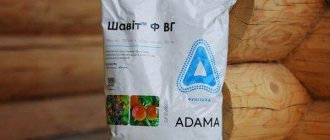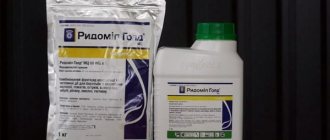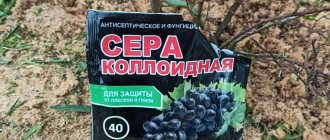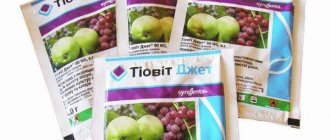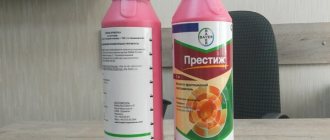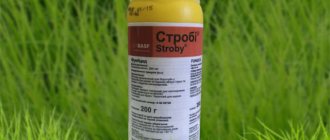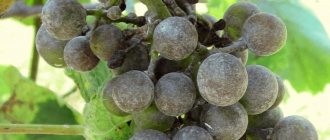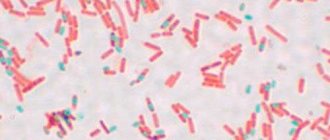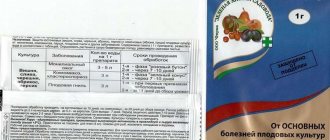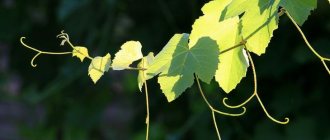You are buying an expensive grape variety. Plant it in a place with sufficient lighting. Water on time. But is this still not enough for a good harvest? It is important not to miss the factor of insect pests and protect the vine from their attack. The consequences of microorganisms living on the grapevine make it weak. And they have a bad effect on the ripening process of berries. Regular preventive maintenance of grapes and one-time sanitary treatments will help save the crop from the negative effects of pests. Sulfur for grapes is one of the best preventative agents.
It is sold in the form of a powder with an admixture in proportions of 80 to 20. Colloidal sulfur for grapes is able to fight fungal pathogens, such as anthracnose, oidium and gray rot. It also kills ticks and prevents the proliferation of harmful insects.
How does it affect grapes?
Colloidal sulfur has a positive effect on grape bushes during the treatment of certain agricultural diseases. First of all, the product helps get rid of fungi.
Sulfur is used not only to combat existing diseases, but also as a prophylactic agent.
For example, for processing and disinfecting planting material before planting in the ground.
In addition to diseases, the substance fights plant mites and prevents the population of these insects from multiplying and destroying crops.
Vineyard dusting
To avoid the hassle of cleaning sprinklers clogged with sulfur crystals, many winegrowers do not spray their grapes, but dust them with colloidal sulfur. In this case, the vine is moistened with clean water, the sulfur is placed in a mesh bag, and sulfur powder is applied to the surface of the leaves and trunk with tapping movements. If the drug is applied to a dry vine, it will be blown away by the wind and the treatment will be useless.
The effectiveness of this method is the same as that of spraying. Some manufacturers skimp on high-quality grinding of sulfur; the crystals are larger than necessary. In this case, dusting is the only option to apply a colloidal sulfur preparation.
Purpose
Colloidal sulfur is used to treat existing diseases, kill insects and as a prophylactic.
Oidium
Oidium is true powdery mildew. A characteristic sign of the disease is the appearance of a white coating on the foliage, the inflorescences fall off before they have time to bloom, and the clusters grow small. Powdery mildew is caused by a fungus.
You can cope with the disease by spraying with colloidal sulfur. This is a very effective remedy. It has a toxic effect on the fungus, causing it to die. The procedure is carried out before flowering begins. 50 g of sulfur is diluted in a bucket of water. You can also add Karbofos to the solution. The resulting substance is sprayed onto the bush. The procedure is carried out daily for 6 days.
Powdery mildew
Unlike true powdery mildew, downy mildew appears on the lower part of the leaf. The leaf plate is covered with a white coating. The berries also become coated and the skin cracks. Almost immediately the grapes either rot or dry out. The vine becomes covered with dark spots.
As with oidium, colloidal sulfur will help cope with downy mildew. Although copper-containing chemicals have the greatest effect.
It is not difficult to prepare the solution. Pour sulfur into a bucket and gradually pour in water, stirring the solution as you do so. It is not recommended to sprinkle sulfur on the eye; there are always exact instructions on the packaging that must be followed. To treat mildew, you need to take 80 g of the drug per 10 liters of water. Bushes should be sprayed no more than 5 times per season.
Anthracnose
The first sign is the appearance of dark spots on all parts of the vine. As it develops, the affected areas dry out and holes form instead of spots. There are two ways to treat grapevines from anthracnose - spraying the bushes completely or treating only the affected part of the leaf. The second method is advisable to use when the disease has just begun to spread.
See also
Characteristics and description of Daria grape variety, planting and care
Read
Treatment is carried out before or after flowering. It is also not worth processing the bush often. Especially if anthracnose has just begun to appear. Often spraying is necessary if most of the bush is already affected.
Gray rot
To combat gray rot, grapes can be treated with sulfur no more than 4 times per season. 80 g of powder are diluted in 10 liters of warm water. The solution is thoroughly mixed and the bushes are treated with it. It is advisable to carry out the treatment before flowering. Due to spraying, the inflorescences may begin to fall off.
The procedure is carried out in the evening, on a sunny, windless day. Before doing this, it is advisable to check the weather forecast so that it does not rain in the coming days.
Fungal diseases
Colloidal sulfur is a non-toxic fungicide for plants. The substance does not penetrate the tissues of the bushes, so its use is safe for the treatment of fungal diseases of grapes.
But despite its safety, frequent use of the fungicide is not recommended. It is advisable to spray the vine no more than 5 times per season. If necessary, if the disease cannot be cured at all, the number of treatments can be increased. Typically, 10 liters of water require 80 g of the substance. But to prevent diseases, the concentration can be reduced.
Colloidal sulfur fungicide: why use?
Sulfur is an excellent remedy in the fight against fungal diseases and mites. As well as preventing their occurrence. Compared to other chemicals, spraying grapes with colloidal sulfur has a number of advantages:
- long validity period;
- efficiency;
- ease of use;
- the price is within the reach of any gardener;
- cost-effectiveness of the product;
- rapid absorption of the solution;
- safety for the environment.
Colloidal sulfur for grapes quickly removes fungal spores. It also has a positive effect on grapes, relieving them of small insects and diseases. Preference is given to this method of treatment because of the ease of working with it. Nowadays, sulfur-containing substances are sold in the country in the form of microgranules. These fungicides include “Cumulus”, “Microthiol special”, “Tiovit Jet”. In water, the granules disintegrate into small particles and form a stable solution.
Instructions for use
When using colloidal sulfur, you must strictly follow the instructions. Putting the substance on the eye can be dangerous both for the grapes and for the person himself.
Deadlines
Before spraying grape bushes, you should decide on the timing. It is advisable to treat the plant before flowering in July.
If sulfur is used to treat diseases that have already appeared, then plants can also be treated after the flowering period, when the ovaries begin to form. The last procedure is carried out no later than 3-4 days before harvest.
Preventive procedures are carried out before buds open in early spring. Prevention helps prevent diseases and mites.
Dosage
Before carrying out the procedure, it is not enough to familiarize yourself with the appropriate time frame for its implementation. It is also worth studying the dosage of the substance. Depending on the purpose, the solution can be made less or more concentrated.
For treatment
To treat grape diseases, it is advisable to take concentrated solutions. Typically, 10 liters of water require 80 g of the substance. This dosage is suitable to combat all diseases. The resulting quantity is enough to process 60 square meters. m of vineyard.
For prevention
For preventive procedures, the amount of substance used can be much less. It is enough to dilute 55 g of sulfur in water and treat the vine with the resulting solution in early spring. Preventive treatment is carried out in dry, windless weather at a temperature of +20-+30 degrees.
Security measures
Colloidal sulfur itself is safe for humans, therefore it is widely used in gardening, but when reacting with other substances, compounds are formed that are dangerous.
In particular, the vapors that appear during the evaporation of sulfur can cause irritation of the bronchi and lungs and provoke asthmatic attacks. Fortunately, the danger is easy to notice - sulfur has a strong, characteristic odor; if you smell it, you need to hold your breath and leave the area as quickly as possible. After treatment, you cannot enter the vineyard for 24 hours; if dusting was used, the wait increases to 3 days. If there is an urgent need, protective respirators are used.
If grapes grow near the house, close the windows before using colloidal sulfur and try to spend less time near the vine. But, as a rule, the concentration of vapors formed after processing several bushes does not pose a danger.
Before you start spraying the bushes with colloidal sulfur, you must wear protective gloves, clothing must cover all parts of the body, and your eyes are protected with glasses. Particular care should be taken if the grapes grow high. It is necessary to use a stepladder and start processing from the lower parts of the vine.
Colloidal sulfur is also used to acidify soil. In this case, it is safer to dig up the soil after applying the drug.
Colloidal sulfur accumulates in grapes in small quantities, since it is essentially a fertilizer, actively participating in metabolic processes. It does not reach a concentration dangerous to humans even with intensive use.
Once you find out what colloidal sulfur is, be sure to try using it to care for your bushes, and they will surely delight you with a healthy appearance and sweet fruits.
How to prepare the solution
Preparing a sulfur solution is quite simple. To do this, you need to take warm water and a large water container. Pour sulfur into a container and add water, then mix the solution thoroughly until the substance dissolves.
See also
How to grow grapes in the Moscow region in open ground without a greenhouse
Read
Protection measures
During the procedure, precautions must be taken. Although colloidal sulfur is not toxic to humans, extra safety never hurts. However, with frequent interaction with the fungicide, allergies may occur.
The vine should be sprayed on a calm day so that drops are not sprayed in all directions. It is better to cover your face with a mask and wear rubberized overalls or a raincoat. The main thing is that the skin is protected.
Composition, dosage form and principle of action
Composition: colloidal sulfur (S) 70-80%, potassium monophosphate, surfactants. Available in the form of a wetting fine powder or water-dispersed granules (WG). Packaged from small bags of 20g, 40g, 100g, to bags of 15kg, 25kg, or 10l. buckets
The granular type is convenient to use because it does not generate dust and requires fewer precautions, although its cost is much higher. The content of free sulfur in any type of preparation is 70-80%, so in terms of efficiency there is no difference between the use of powder or granules.
The color of sulfur depends on the conditions of its formation and can be of different shades from pale yellow to brown. Color also does not affect the effectiveness of use.
Color difference of colloidal sulfur
Sulfur can be of natural origin or produced at industrial chemical plants.
The principle of operation is based on the fact that gaseous sulfur S, acting on a biomaterial, takes away hydrogen ions from it and thereby destroys its metabolism. Hydrogen sulfide H2S is released as a by-product - an unpleasant and fetid odor that characterizes sulfur.
Storage conditions
Colloidal sulfur must be stored out of the reach of pets and children. A cool place where the sun's rays do not penetrate is suitable for storage. It is also important not to allow the fungicide to be stored in the same place as medications and food. Sulfur is a flammable substance, so leaving it near the stove or heating is also prohibited.
